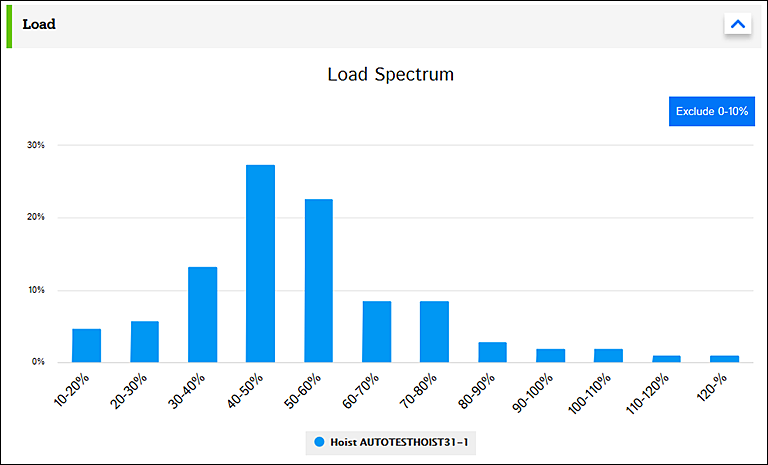Load
This section is available only if the crane is equipped with a load cell and load data is available.
The section contains a load spectrum graph, which reflects the production volume of the crane or hoist.
The load spectrum graph shows how heavy loads the hoists have been handling since their installation. More specifically, the graph presents the distribution of loads of different weight and reveals whether the crane is in heavy or light use.
All loads that the hoists have handled are divided into load groups: 10%–20%, 20%–30%, and so on. A load group presents the weight of the load mass as a percentage of the rated capacity of the hoist or crane.
In practice, load group 0%–10% refers to operating the crane with an empty hook. You can exclude that load group from the graph with the Exclude 0-10% button top right. Load groups 100%–110% and above refer to overload attempts.

By reviewing the graph, you can spot the most usual load groups in which the hoists are used. If loads are at or in excess of 50%, increased attention to maintenance is required. Especially, if a hoist continuously lifts loads close to its maximum 100% level, its structures burden more and its service life shortens faster. By looking at the frequency of overloading and how often the load spectrum reaches the rated capacity, it is also possible to assess the suitability of the crane for the current type of operation.
In the graph, the x-axis shows the load group. The y-axis (height of the bars) reflects the share of each load group from the total.
Here, it is the gross load that is considered. Gross load includes all masses that are suspended directly from the crane: the weight of the actual lifted load (payload), rope slings (non-fixed load-lifting attachments), hook block and hook (fixed load-lifting attachments), and ropes hanging down from the crab (lifting media).
If the crane has more than one hoist, all hoists are by default shown in the graph, each having its own color code. By clicking the hoist buttons below the graph, you can get only one or some of the hoists to the graph.
There are no warning or alert statuses for loads, so the traffic light is always green.
